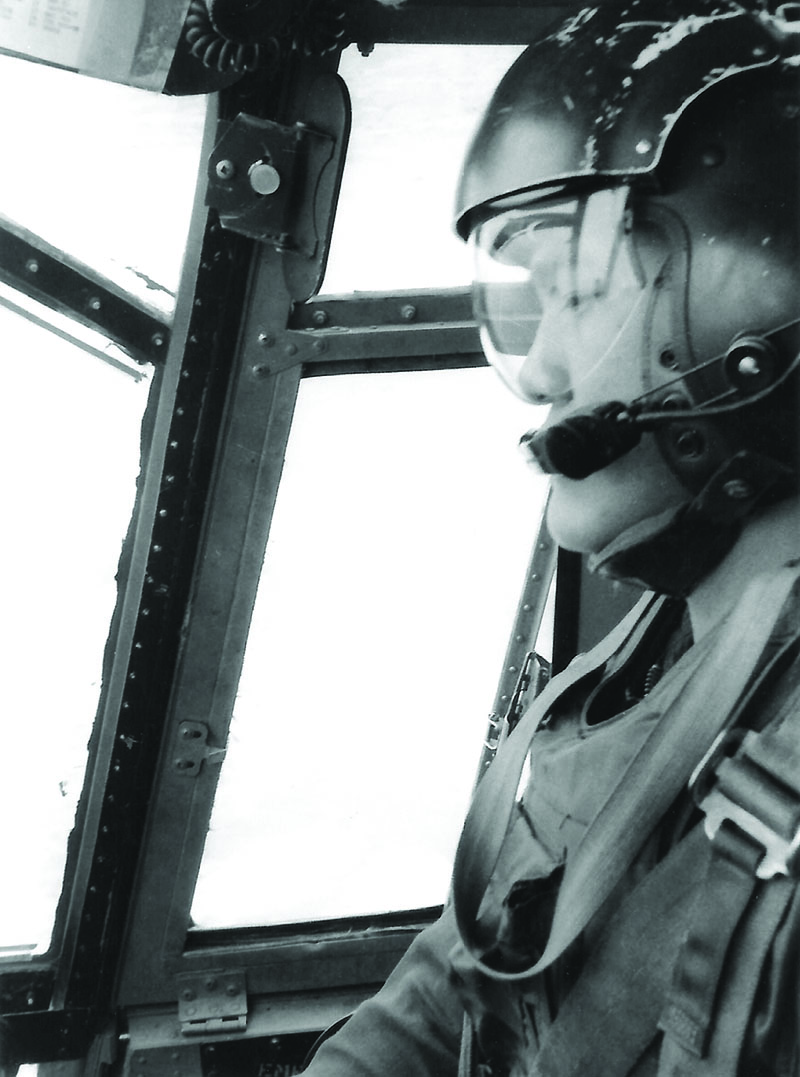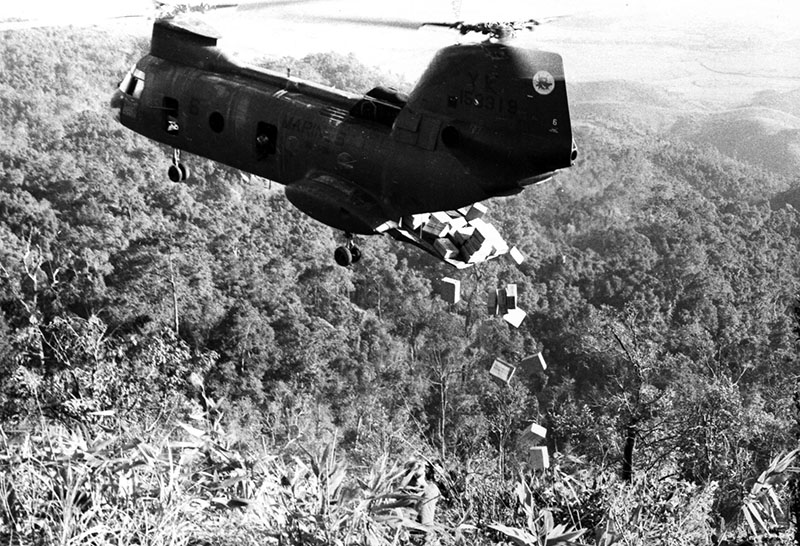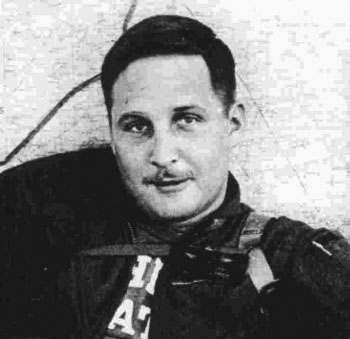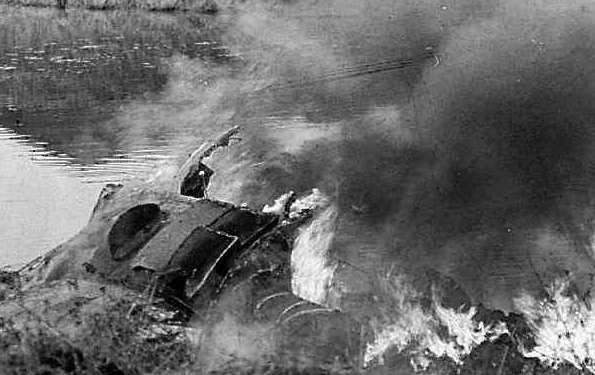
Cheating Death in Vietnam
By: Michael Dan KellumPosted on May 1, 2025
Editor’s note: The following is a Leatherneck archives story from May of 2018. We are re-publishing it in recognition of Asian-American and Pacific Islander Heritage Month.
Few people know what it’s really like to cheat death, but many Marines and Navy corpsmen posted to combat zones certainly do. Sir Winston Churchill put it best when he wrote, “Nothing in life is so exhilarating as to be shot at without result.” Combat veterans probably would say, “amen” to that.
First Lieutenant Earl Masaji “Pineapple” Miyamoto, from Kaneohe, Hawaii, is an example of a Marine with multiple “exhilarating moments” in Vietnam during which he cheated death. He flew Sea Knight helicopters for HMM-364, the “Purple Foxes,” from July 1970 to February 1971.
Pineapple was what other pilots called “a good stick”-a competent pilot with whom it was enjoyable to fly. But first he had to build up his confidence as a copilot under fire. In his early training, he was paired with experienced pilots like First Lieutenant Jerry “Weasel” White, 1stLt Art Blades and Major Neil R. Van Leeuwin, who flew with Pineapple on an early medevac run on Charlie Ridge, where they took roughly 24 to 28 hits to their aircraft.
“Van Leeuwin asked me as we approached the LZ [landing zone], ‘OK, I think we’ll go in high speed, low level. What do you think?’ And I’m like, ‘What are you asking me for? I’m brand new in country. I don’t know anything about anything. I’m scared to death.’ The major says, ‘I think it’s just over this ridge. What do you think?’ I’m supposed to be the navigator but I was so awed at the time.”
Maj Van Leeuwin did a button hook and popped up over the ridgeline. He put the helicopter in a 30- to 40-foot hover as the crew chief talked them down into the LZ. Suddenly Pineapple heard this
“THWACK! THWACK! THWACK!” sound over the roar of the engines. He asked, “What’s that? What’s that?”
“We’re taking fire,” the major said calmly.
“I tried to get as small as I could in my seat,” chuckled Pineapple. “It sounded like bamboo whacking a carpet. The rounds went right through the thin skin of the helicopter.
“Understand this was the first time I had gone out and taken fire. One gunner got shot in the back and our crew chief took a round off the top of his helmet. We took out some treetops with our front and back blades to take a Marine casualty out of the zone.”

As a newbie copilot, then-lstLt Miyamoto seemed to attract bad luck, drawing fire every time he went out on a medevac or reconnaissance team extract. He was given the nickname “Magnet Ass.”
“I think that’s why they made me a pilot, as no one wanted to fly with me as a copilot,” Miyamoto said.
He would finish his flying career with 22 Air Medals, 20 air missions equaled one Air Medal and if they were shot at, two Air Medals were awarded. The events of Sept. 20, 1970, represented a typical day in Vietnam running medevac flights.
Pineapple was the copilot on a mission to pick up two Marine casualties 25 miles southwest of DaNang in a mountainous area. Marines on the ground were heavily engaged with the enemy and using a hoist was not an option; it would make their two casualties easy targets for the enemy. Pineapple and his aircraft commander worked as a team to coordinate the approach to a suitable LZ under the cover fire of a UH-1NHueygunship. They successfully took on the two wounded Marines and flew them to Da Nang. Pineapple received an Air Medal and a Bronze Star with the citation noting that the Sea Knight crew flew two more emergency medevacs that same day.
When asked how he got the nickname “Pineapple,” Miyamoto explained, “Some people called me ‘Pineapple’ and others called me ‘Samurai’ due to my Japanese heritage. ‘The Go For Broke’ 442nd Army Combat Team won a number of honors in World War II and were called ‘Pineapples,’ so it was a distinction to be called that for those Japanese-American troops primarily from Hawaii. I had a little pine apple painted on the back of my helmet for luck.”
He admitted that as an Asian-American, he feared the “special attention” the enemy might give to him should he ever be captured. Ancestors from both sides of his family came from the samurai warrior class in Japan. A namesake ancestor, Miyamoto Musashi, was a famous “sword saint” and philosopher revered in the Japanese culture for his use of two swords in duels, winning 60 sword fights before the age of 29. Pineapple’s wife, Wendy Takagawa, also is descended from the samurais.
It only seems natural that the descendant of samurai warriors and the namesake of a famous expert two-sword fighter would end up flying a Sea Knight with its two sets of three 30-foot rotor blades atop of the helicopter in the front and back. Like Musashi, Pineapple’s philosophy in the combat zone was to “conquer his fear,” “do his job” and “accept dying, as it went with the territory.”

Just 13 days before his squadron was to stand down from the war, Pineapple’s aircraft was shot down by the enemy on Feb. 5, 1971. This was the third time he was shot down in Vietnam. He flew the lead aircraft on a medevac call to pick up a Korean Marine who had lost his legs to a 105 mm artillery shell on a road sweep on Highway 4 near Ha Nong Trung. Due to a low cloud ceiling of about 60 feet, he instructed his chase Sea Knight, flown by lstLt Larry J. “Harvey Wallbanger” Thompson, to execute a “turn and burn” at LZ Baldy as he flew on with the two AH-lW Super Cobra gunships. After picking up the casualty, another medevac call came into assist a Vietnamese woman peppered with shrapnel from a Bouncing Betty mine four clicks away near Nhi Kinh. He decided to pick her up as well, as it was on the way back to Da Nang and Charlie Med.
En route to the Vietnamese casualty, Pineapple flew along a river that came back on itself in a “C” shape and took fire from a large enemy element. The rounds severed a hydraulic line and damaged an aft transmission and mix box. Hospitalman John V. “Flyin’ Doc” Kickham Jr., 21, from Berea, Ohio, was leaning over his patient plugging up his wounds as the rounds went right over his head. He was covered with hydraulic fluid and would have likely been killed if he raised his head.
Pineapple put out a distress call to Thompson and headed to the nearest friendly camp. He flew at about 125 knots (175-180 miles per hour) and 15-20 feet off the ground, riding his air cushion, with one engine knocked out and the other losing its hydraulics and about to seize up. He wrestled the sluggish controls. When he got to the Republic of Korea Marine Corps (ROKMC) compound at an old French fort, he flared to land. His controls froze up, sending the Sea Knight into the clouds. Then, after losing lift, the aircraft dropped like a rock. He told his crew to brace themselves for a crash landing as he continued to fight the controls.
“I remember thinking this time I had bought it. I’m not going to get out of this one. My life didn’t flash before my eyes. The only thing I remember thinking was that I hadn’t told Wendy I loved her the last time we talked. I closed my eyes and braced for it and made one of the nicest landings I’d ever done.”
The Sea Knight pancaked mostly in a large pond with a portion of the helo on shore. The blades hit the water then the helicopter flipped onto its starboard side. Pineapple helped to unstrap his copilot, lstLt Tom Dewitt, and looked back into the helicopter, as his crew began to crawl out of the aircraft. Miraculously, they all had survived the crash.

Up on the side of the Sea Knight, Pineapple was joined by one of the gunners, and Corporal J.R. Jones, a Marine photographer and correspondent from Marine Air Base Squadron-16 (MABS-16) who had left Thompson’s chase helicopter at LZ Baldy to join Pineapple’s crew thinking the lead helicopter would get more action. He got his wish and more. Cpl Charlie W. Hansen, the crew chief, emerged from the wreckage and was in shock as he sloshed ashore.
Flyin’ Doc Kickham, soaked in hydraulic fluid, stayed inside with his Korean patient and saw the three men waving for him to come out of the large square escape window. Kickham handed the Korean to Pineapple who grabbed him by his arm when the fuel tanks exploded and a ball of fire set Doc Kickham on fire. Pineapple and the other two men were thrown off the helicopter by the force of the blast.
Though Pineapple had his visor down on his helmet, his eyebrows were still singed. Doc Kickham lost his hold on the Korean and staggered back toward the cockpit area, waving his flaming arms. He fell through a window under the water and decided to swim out, only to get entangled by barbed wire underwater. He managed to extricate himself from the barbed wire and swim away from the helicopter. Three ROK Marines jumped in the water to help Doc Kickham. Unfortunately, Kickham’s patient did not survive the blast and ensuing flames.
For Doc’s attempt to save his patient, Pineapple recommended him for the Navy Cross; he was awarded a Silver Star. He sustained second-degree burns to his face, hands, back and leg, as well as various other minor injuries. Pineapple did not receive a medal for his actions, nor did he seek one, as he felt he had put his crew at risk and therefore was not worthy of a medal. Pineapple was impressed to see Thompson arriving without gun cover shortly after the explosion. He took Pineapple and his crew out to the hospital ship USS Sanctuary (AH-17).

Back at Marble Mountain Air Facility the next morning, Pineapple was so sore that he felt as though he had been beaten in an alley. He gazed out at the South China Sea as the sun rose outside his hooch, simply taking a breath, letting it out, taking a breath and letting it out again.
“You know, I never realized how nice it was just to breathe. Life is so short and precious. You never know what’s coming around the corner. I gained such an appreciation for life and being able to just breathe.”
The “samurai” pilot with nine lives flew two more missions on Feb. 7 and 10. The squadron flew its last combat mission on Feb. 15, 1971. HMM-364’s commanding officer, Lieutenant Colonel Henry W. “Hank” Steadman, sent Pineapple for temporary duty to Japan to continue flying by ferrying repaired Sea Knights to the base at Kyoto, Japan.
Miyamoto and his flight crew earned a unique place in the Purple Fox squadron’s combat history in Vietnam, as their aircraft was the last HMM-364 Sea Knight to be shot down during the Vietnam War. After returning from Vietnam, he and Wendy made their home in Kaneohe, Hawaii. He was no longer able to fly due to complications with his vision and was forced to take an administrative position. He retired and became involved in the civilian aviation industry briefly before going back to the Marine Corps as deputy chief of staff, Marine Corps Forces Pacific, and later as a civilian.
His job was to visit Marine bases on the West Coast, assess their needs and see that they got the support they needed. He proudly noted he was the first Japanese-American to hold such a post. He thought that would have made his father proud.
Author’s bio: Michael Dan Kellum is the author of Books I and II, American Heroes: Grunts, Pilots & “Docs.” This story comes from Book I and is condensed from two chapters on retired Major Miyamoto. Kellum and Miyamoto became friends as enlisted Marines at Camp Pendleton in 1968 and both were commissioned officers through the Enlisted Commissioning Program in the TBS class of C-69.




